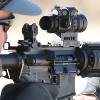A friend of mine just got his first AR, and is looking for a sight system similar to the ACOG or EOTech - just not as expensive (he started a new job and doesn't have alot of $$$ at the moment) - any suggestions would be helpful!
Hmmm. The Eotech 516 is about $440, which is still plenty steep, so if that's out of his price range then I've heard relatively good things about the Primary Arms knockoffs of Aimpoints, and the Vortex Strikefire. The Primary Arms Micro is about $80 (or $108 including a riser for a lower-1/3 cowitness) and the Vortex Strikefire is about $150.
Here's an m4carbine.net thread on the Primary Arms Micro, which is probably the best of the sub-$100 optics, bar none. The customer service is also reportedly quite good.
http://www.m4carbine.net/showthread.php?t=53171
The manufacturer's page:
http://www.primaryarms.com/product.sc?productId=303
You do get what you pay for---it's not as durable as an Aimpoint Micro, the optical quality isn't quite as good, and battery life is 250 hours instead of 50,000 hours---but it's $80-$110 instead of $500. Notice that you'll need the $29 riser to get a lower 1/3 cowitness, or $108 total.
Another decent optic, albeit more expensive (but not necessarily superior) is the Vortex Strikefire.
http://www.vortexoptics.com/product/vortex-strikefire-red-dot-scope-red-dot-only-ar15-mount
m4carbine.net thread on the Strikefire:
http://www.m4carbine.net/showthread.php?t=51173&highlight=strikefire+primary
On the Vortex, it has been mentioned that the red-dot-only version (the one I linked) is better for serious use than the red/green-dot version, because the latter doesn't go as bright and can wash out in bright sunlight.
From personal experience, I'd suggest avoiding all other inexpensive red dots. I tried a $40 Tasco ProPoint from Walmart (zero wandered some, serious parallax issues, the tube coating flaked off
inside the tube and scratched the inside of the front lens) and a $45 NCStar reflex sight (built like a toy, matchbox-car-metal battery cover was 100x easier to crossthread than to screw on straight and was almost impossible to avoid scratching the lens with, and wouldn't cowitness). And avoid at all costs the fake Chinese made Eotech "replicas" that are actually just cheaply made red dots intended for Airsoft toys.





